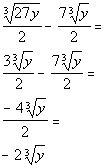

![]()
Can you think of what that factor is?
Let's see what we get when we simplify the second radical:


![]()

*Cube root of 27 is 3

![]()
AND
Step 2: Simplify
the radicals.

![]()
AND
Step 2: Simplify
the radicals.

Last revised on July 21, 2011 by Kim Seward.
All contents copyright (C) 2001 - 2011, WTAMU and Kim Seward.
All rights reserved.